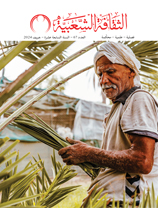The Sudanese Woman And the Musical Culture
Issue 12

Ali Ebrahim AL Dhaw (Sudan)
The researcher attempts to own some of the courage of the Sudanese identity to find out some explanations which are logically consistent with the ideas dominate the domain of the female. Concentration in this research is made on times when this woman created musical performance such as the dances of the bride and the Zar.
The bride’s dance is, in brief, a musical show performed only by the bride as a part of the rituals of the wedding. The show is never performed outside this context as it is usually preceded by intensive preparations. The show consists of a group of dances designed basically and clearly to display the beauty of the body of the bride. This body should be flexible enough to follow the rhythm of the songs. The bride is usually trained by the al ’aama or the master who should be a female. The master also trains the bride other behaviors to help her for the initiation of being a woman and no longer a girl. On the other hand, the rituals of the Zar are extensively feminine. If a woman is ill, it is thought, that she is transfigured by some evil souls mainly al rih al ahmar, the red wind. It is only the duty of the Zar shiekha who could cure the woman. The Shiekha plays the role of the mediator between the woman and the evil soul. The Zar ceremony is basically a musical show dominated by the rhythm. According to the traditional ’Atabaelief, every woman has her own rhythm. Whenever this rhythm is played the woman could not help resisting it. It is also believed that it is the red wind which dances. It is observed that the melodies and the rhythm attracts that who listen and participate in the show in case he/she is inflicted by the red wind. In such a case the person behaves just like a sufist in the Dhikr performance. The understanding of the musical structure of the Zar show remarkably helps understand this traditional practice. Otherwise, we are only looking to the show as outsiders and judge it with unilateral criterion. Just after the wedding and after the end of the period of the colorful dreams, the woman who is no longer a girl starts her new life as a housewife. Sometimes the infliction might be sever and accompanied by stress. So the woman is obliged to get rid of this situation by consulting al reeh al ahmar once more.
The bride’s dance is, in brief, a musical show performed only by the bride as a part of the rituals of the wedding. The show is never performed outside this context as it is usually preceded by intensive preparations. The show consists of a group of dances designed basically and clearly to display the beauty of the body of the bride. This body should be flexible enough to follow the rhythm of the songs. The bride is usually trained by the al ’aama or the master who should be a female. The master also trains the bride other behaviors to help her for the initiation of being a woman and no longer a girl. On the other hand, the rituals of the Zar are extensively feminine. If a woman is ill, it is thought, that she is transfigured by some evil souls mainly al rih al ahmar, the red wind. It is only the duty of the Zar shiekha who could cure the woman. The Shiekha plays the role of the mediator between the woman and the evil soul. The Zar ceremony is basically a musical show dominated by the rhythm. According to the traditional ’Atabaelief, every woman has her own rhythm. Whenever this rhythm is played the woman could not help resisting it. It is also believed that it is the red wind which dances. It is observed that the melodies and the rhythm attracts that who listen and participate in the show in case he/she is inflicted by the red wind. In such a case the person behaves just like a sufist in the Dhikr performance. The understanding of the musical structure of the Zar show remarkably helps understand this traditional practice. Otherwise, we are only looking to the show as outsiders and judge it with unilateral criterion. Just after the wedding and after the end of the period of the colorful dreams, the woman who is no longer a girl starts her new life as a housewife. Sometimes the infliction might be sever and accompanied by stress. So the woman is obliged to get rid of this situation by consulting al reeh al ahmar once more.



































































